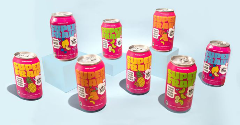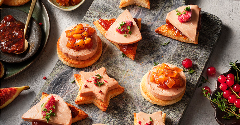Practical Innovation says it can help start-ups succeed
25 Jul 2018Only 0.5% of food product launches achieve success in the marketplace, according to Practical Innovation, an innovation starter company. For food companies to beat those odds, real innovation is a key factor for product success, it says.

Only 0.5% of food product launches achieve success in the marketplace, according to Practical Innovation, an innovation starter company. For food companies to beat those odds, real innovation is a key factor for product success, it says. Practical Innovation helps food and food ingredient companies develop innovative products just like any start-up, yet can break the old paradigm of marketing the same products on a reduced margin that sets the product up for eventual failure.
There is a huge gap between start-ups that launch innovative products and traditional companies who don’t, irrespective of company scale, the company says. Utilizing the multidisciplinary expertise of professional innovators is necessary to drive the changes required and launch win-win products.According to Practical Innovation, many established food companies want to develop new products and increase sales and revenues, but to do so involves harnessing tremendous efforts and resources that are not always available to traditional companies such as bakeries and sweetener companies.Starting an innovation process in an existing company that has produced the same products over many years is, Practical Innovation claims, fraught with stumbling blocks. With so much at risk, older—and larger—companies are persistently driven toward making only minor changes rather than true innovations. Being inherently risk-averse, they might only add a new flavor, improve packaging, or simply cut costs. Creating innovation from inside presents multiple challenges.“Gambling your reputation in the market with a new product that might not survive on-shelf is a huge impediment,” said Tal Leizer, CEO of Practical Innovation. “If you want to succeed in the competitive food market, the very first step is to take failure off the table and start thinking audaciously, like a start-up.”Leizer shares a few tips how to revive the innovation process in your company:1. Think like a startup, literally – search for creative ideas even if those ideas seem impossible.2. Do your research –this is the most complicated mission in the project and it involves market research, identifying important food trends, and knowing what the market wants now...and five years from now.3. Set SMART goals: Specific, Measurable, Attainable, Relevant, Time-bound4. Make your concept feasible and scalable.5. Develop a complete plan from concept to market (and beyond,)6. Make sure the product meets the genuine needs of the target consumer and solves real problems for which they are seeking solutions.7. Get help from a professional innovation company. Practical Innovation cites a case study.Recommendations to reduce sodium, sugar, and fat in the diet established by the global health bodies FDA and WHO spurred Leizer to see the challenge as a great opportunity for clients to develop new ingredients and products to meet the growing demand for healthy, tasty products.Recognizing the consumer quest for healthier sugar alternatives, Practical Innovation says it reinvented the sweetener category by developing Liteez, a dual-purpose, sugar-free, vegan meringue “kiss” sweetener for sweetener company, Lampados. The product is composed of the natural sugars inherent in prebiotic vegetable fibres, and that can dissolve in and sweeten a hot beverage or be enjoyed as an ultra-low calorie sweet treat.“When a company approaches us, in many cases they already are losing market share and have hastily responded with price drops to try and hold their brand in the marketplace,” says Leiser. “Building a robust plan is crucial to maintaining any new strategy and to assess its feasibility for implementation. Such a plan should also encompass areas of large-scale production, developing niche markets, and assessing prospects for international export.”“Even more pertinent is to guide all the product characteristics, from texture, taste, and functionality through to packaging, as well as crafting an indulgent flavour while being sure the concept meets the real demands of the consumer,” adds Leizer. “We don’t just develop different packaging or a new flavour, but reinvent every aspect of a product, from concept to product launch, all while encompassing formulation with simple, natural ingredients according to the current food trends. And, we make sure our innovative products have patentability.”Related news

Plastic packaging reduction requires industry rethink
6 Jan 2023
The food and beverage sector is calling for industry-wide collaboration and business model updates to reduce the environmental impact of plastic packaging.
Read more
Asian beverage brands deal with rising costs
4 Jan 2023
Decreasing bottle sizes or increasing prices? Asian beverage brands are finding “creative approaches” to manage rising costs, according to industry analysts.
Read more
Superfrau upcycles liquid whey for energy drinks
22 Dec 2022
US company Superfrau turns surplus whey into sustainable, upcycled-certified dairy products for the recovery drinks market.
Read more
Malaysian brand Nanka brings jackfruit range to Europe
21 Dec 2022
Malaysian brand Nanka is expanding to new Asian and European markets with its fast and ready-to-eat plant-based products based on jackfruit.
Read more
Plant-based fish and seafood launches around the world
12 Dec 2022
From pea protein-based prawns to microalgae-based tuna alternatives, plant-based alternatives to fish and seafood are on the rise around the world.
Read more
Editors’ choice: Our roundup of the most innovative sweets, snacks and bakery products
9 Dec 2022
The sweets, snacks, and bakery categories are an exciting area, full of fresh and innovative products which are constantly adding meaningful value to the sector.
Read more
Functional food in Japan centres on health and proving claims
8 Dec 2022
The latest Japanese functional food and drink trends put health and product efficacy firmly on the production agenda for new releases.
Read more
Editor’s choice: Our roundup of the latest women’s health products around the world
2 Dec 2022
From botanicals to combat menopause symptoms to a hydration powder for mothers-to-be, here is our roundup of the most innovative new product launches within women’s health.
Read more
Nestlé becomes latest brand to launch vegan version of foie gras
1 Dec 2022
Foie gras, a traditional staple of Christmas dinner across France and other European countries, has long been a controversial delicacy. Now, Nestlé has become the latest company to create a cruelty-free vegan version under its Garden Gourmet brand.
Read more
Nestlé launches plant-based egg in Latin America
29 Nov 2022
Nestlé has launched a powdered plant-based protein under its Mahler brand that consumers can add to egg dishes such as omelettes, allowing them to make dishes that are cheaper but still nutritious, it says.
Read more